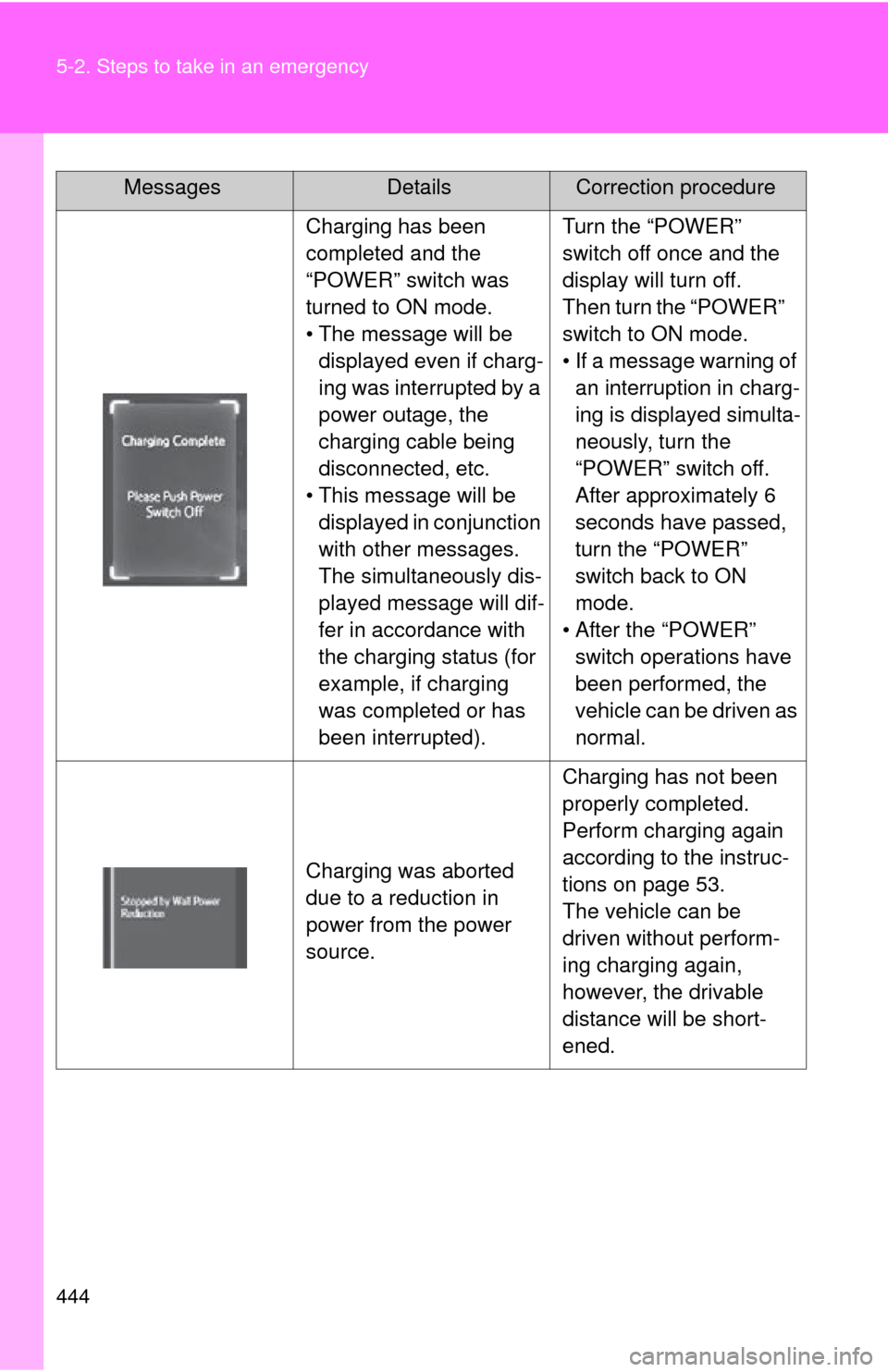Page 438 of 520
438 5-2. Steps to take in an emergency
Indicates that the park-
ing brake is still
engaged. flashes and a
buzzer sounds to indi-
cate that the parking
brake is still engaged
(with the vehicle having
reached a speed of 3
mph [5 km/h]). Release the parking
brake.
Indicates that the
washer fluid level is low. Add washer fluid.
Due to the amount of
charge remaining in the
traction battery being
high, power regener-
ated through regenera-
tive braking is reduced. Apply the brake pedal
as needed to slow
down.
(Flashes) The driver's door is
opened when the
transmission is out of
P with the EV system
on.
Push the P position
switch.
Warning messageDetailsCorrection procedure
Page 439 of 520
5
When trouble arises
439
5-2. Steps to take in an emergency
(Flashes)
Indicates that the
accelerator pedal is
depressed while the
shift position is in P.
A buzzer also sounds.
Release the accelera-
tor pedal and shift the
shift position to D or R.
(Flashes) Indicates that the
accelerator pedal is
depressed while the
shift position is in N.
A buzzer also sounds.
Release the accelera-
tor pedal and shift the
shift position to D or R.
Warning messageDetailsCorrection procedure
Page 440 of 520
440 5-2. Steps to take in an emergency
Have the malfunction repaired immediately.After taking the specified steps to correct the suspected problem,
check that the warning message and light turn off.
Interior buzzerExterior buzzerWarning messageDetailsCorrection procedure
Once
(Comes on for 10 seconds.)
(Flashes) The electronic
key is not
detected when
attempting to
start the EV
system.
Confirm
the loca-
tion of the
electronic
key.
Once 3 times (Flashes)An open door
other than the
driver’s door is
closed while the
electronic key is
outside the
detection range
and the
“POWER”
switch is in
ACCESSORY
or ON mode.
Confirm
the loca-
tion of the
electronic
key.
Page 441 of 520
5
When trouble arises
441
5-2. Steps to take in an emergency
Once 3 times
(Flashes)An open door
other than the
driver’s door is
closed while the
electronic key is
outside the
detection range
and the
“POWER”
switch is in
ACCESSORY
or ON mode
with the shift
position in P.
Turn the
“POWER”
switch to
off or con-
firm the
location of
the elec-
tronic key.
Contin-
uous
(Flashes)The driver’s
door has been
opened with the
shift position in
a position other
than P and with-
out first turning
the “POWER”
switch off.
Put the
shift posi-
tion into P.
Once The electronic
key battery is
low.Replace
the bat-
tery.
(
P. 383)
Interior
buzzerExterior buzzerWarning messageDetailsCorrection procedure
Page 442 of 520
442 5-2. Steps to take in an emergency
Once
(Flashes)An open door
has been
closed and the
“POWER”
switch has been
turned twice to
the ACCES-
SORY mode
from off.
Press the
“POWER”
switch
while
depress-
ing the
brake
pedal.
(Flashes)Indicates that
the steering
lock has not
released within
3 seconds of
pressing the
“POWER”
switch.
Press the
“POWER”
switch
again while
turning the
steering
wheel with
the brake
pedal
depressed.
Interior
buzzerExterior buzzerWarning messageDetailsCorrection procedure
Page 444 of 520

444 5-2. Steps to take in an emergency
Charging has been
completed and the
“POWER” switch was
turned to ON mode.
• The message will be displayed even if charg-
ing was interrupted by a
power outage, the
charging cable being
disconnected, etc.
• This message will be displayed in conjunction
with other messages.
The simultaneously dis-
played message will dif-
fer in accordance with
the charging status (for
example, if charging
was completed or has
been interrupted).Turn the “POWER”
switch off once and the
display will turn off.
Then turn the “POWER”
switch to ON mode.
• If a message warning of an interruption in charg-
ing is displayed simulta-
neously, turn the
“POWER” switch off.
After approximately 6
seconds have passed,
turn the “POWER”
switch back to ON
mode.
• After the “POWER” switch operations have
been performed, the
vehicle can be driven as
normal.
Charging was aborted
due to a reduction in
power from the power
source.
Charging has not been
properly completed.
Perform charging again
according to the instruc-
tions on page 53.
The vehicle can be
driven without perform-
ing charging again,
however, the drivable
distance will be short-
ened.
MessagesDetailsCorrection procedure
Page 463 of 520

5
When trouble arises
463
5-2. Steps to take in an emergency
CAUTION
●After inflation of the tire has comp
leted, the sealant may splatter when
the hose is disconnected or so me air is let out of the tire.
●Follow the operation procedure to repair the tire. If the procedures not
followed, the sealant may spray out.
●Keep back from the tire while it is being repaired, as there is a chance
of it bursting while the repair ope ration is being performed. If you
notice any cracks or deformation of the tire, turn off the compressor
switch and stop the repair operation immediately.
●The repair kit may overheat if operated for a long period of time. Do not
operate the repair kit continuously for more than 35 minutes.
●Parts of the repair kit become hot during operation. Be careful when
handling the repair kit during and after operation. Do not touch the
metal part around the connecting area between the bottle and com-
pressor. It will be extremely hot.
●Do not attach the vehicle speed warning sticker to an area other than
the one indicated. If the sticker is attached to an area where an SRS
airbag is located, such as the pad of the steering wheel, it may prevent
the SRS airbag from operating properly.
■Driving to spread the liquid sealant evenly
Observe the following precautions to reduce the risk of accidents.
Failing to do so may result in a loss of vehicle control and cause death or
serious injury.
●Drive the vehicle carefully at a lo w speed. Be especially careful when
turning and cornering.
●If the vehicle does not drive straight or you feel a pull through the
steering wheel, stop the vehicle and check the following.
• Tire condition. The tire may have separated from the wheel.
• Tire inflation pressure. If the tire inflation pressure is 19 psi (130
kPa, 1.3 kgf/cm
2 or bar) or less, the tire may be severely dam-
aged.
Page 493 of 520

493
6-1. Specifications
6
Vehicle specifications
■
Treadwear
The treadwear grade is a comparative rating based on the wear
rate of the tire when tested under controlled conditions on a speci-
fied government test course.
For example, a tire graded 150 would wear one and a half (1 - 1/2)
times as well on the government course as a tire graded 100.
The relative performance of tires depends upon the actual conditions
of their use, however, and may depart significantly from the norm due
to variations in driving habits, service practices and differences in
road characteristics and climate.
■ Traction AA, A, B, C
The traction grades, from highest to lowest, are AA, A, B and C,
and they represent the tire's ability to stop on wet pavement as
measured under controlled cond itions on specified government
test surfaces of asphalt and concrete.
A tire marked C may have poor traction performance.
Warning: The traction grade assigned to this tire is based on braking
(straight ahead) traction tests and does not include cornering (turn-
ing) traction.
■ Temperature A, B, C
The temperature grades are A (the highest), B, and C, represent-
ing the tire's resistance to the generation of heat and its ability to
dissipate heat when tested under controlled conditions on a speci-
fied indoor laboratory test wheel.
Sustained high temperature can cause the material of the tire to
degenerate and reduce tire life, and excessive temperature can lead
to sudden tire failure.
The grade C corresponds to a level of performance which all passen-
ger car tires must meet under the Federal Motor Vehicle Safety Stan-
dard No. 109.
Grades B and A represent higher levels of performance on the labo-
ratory test wheel than the minimum required by law.